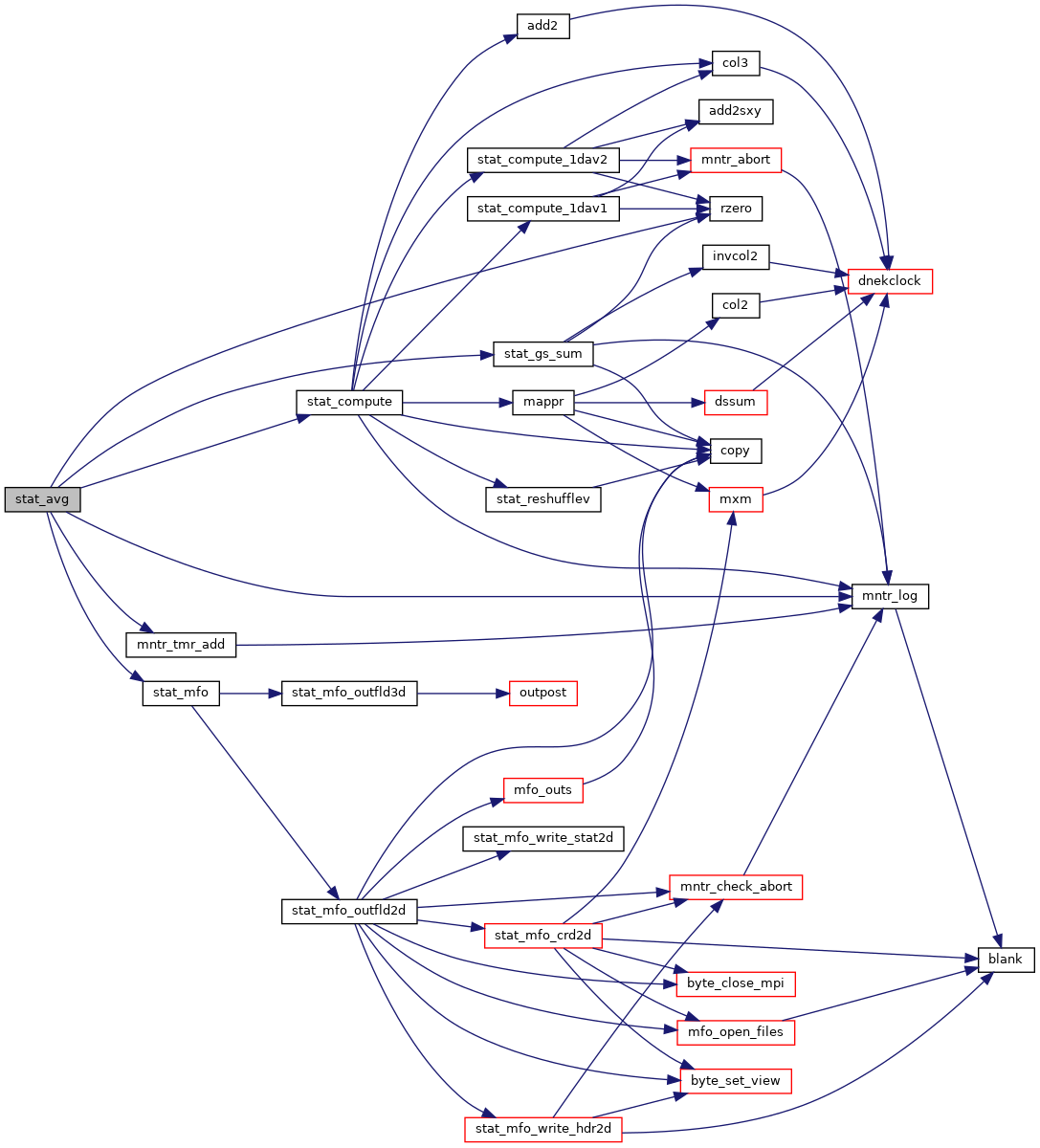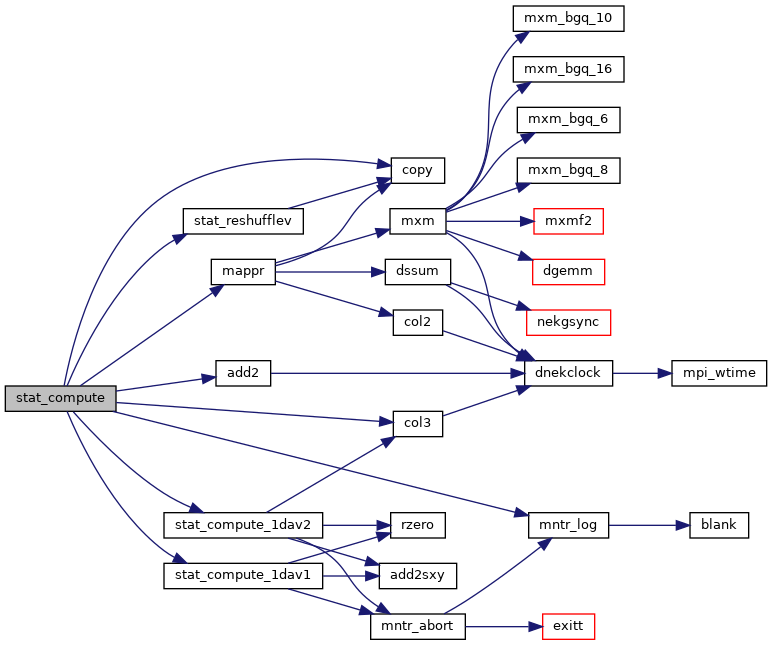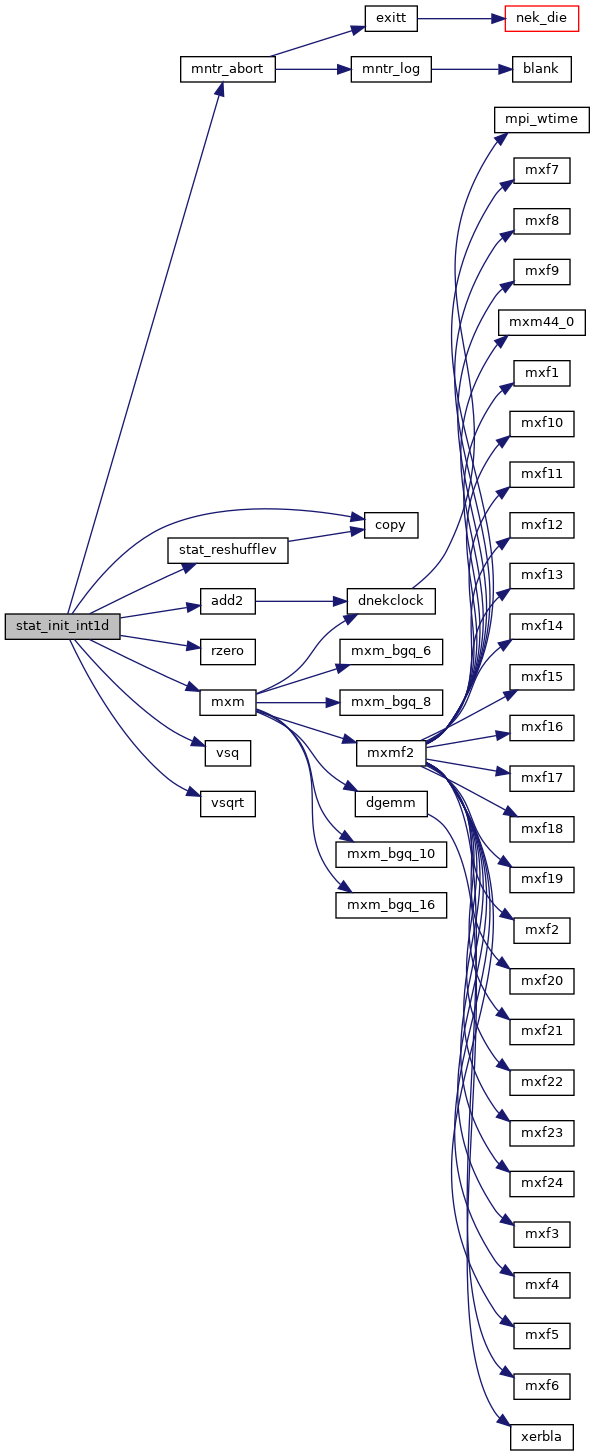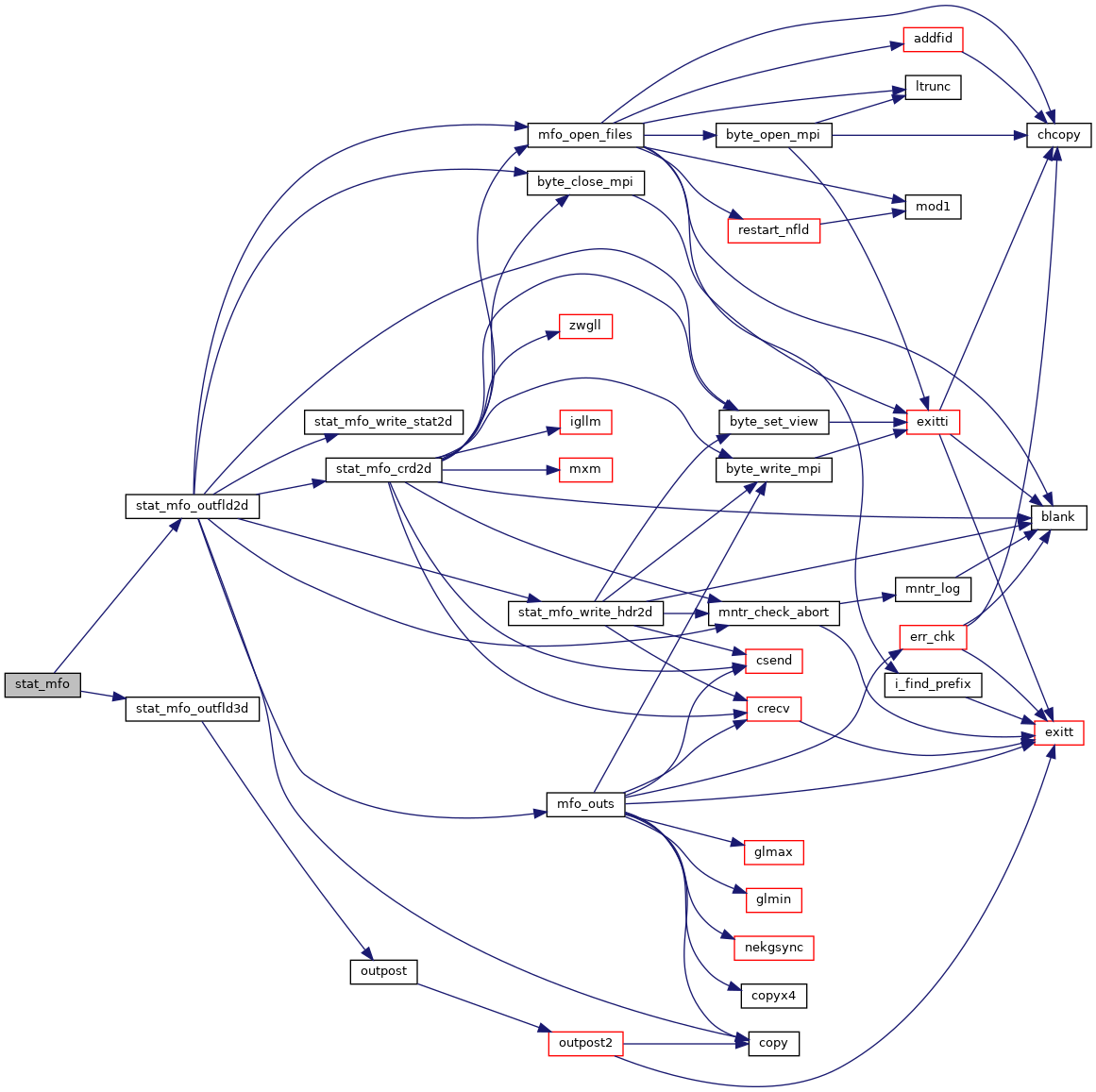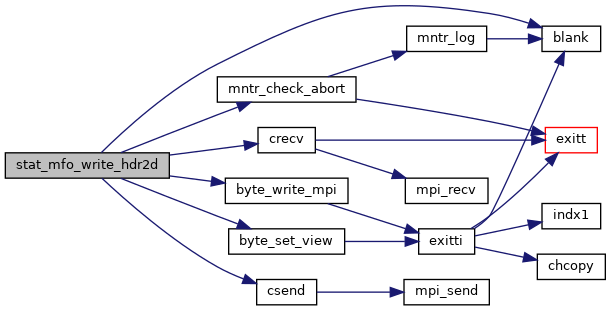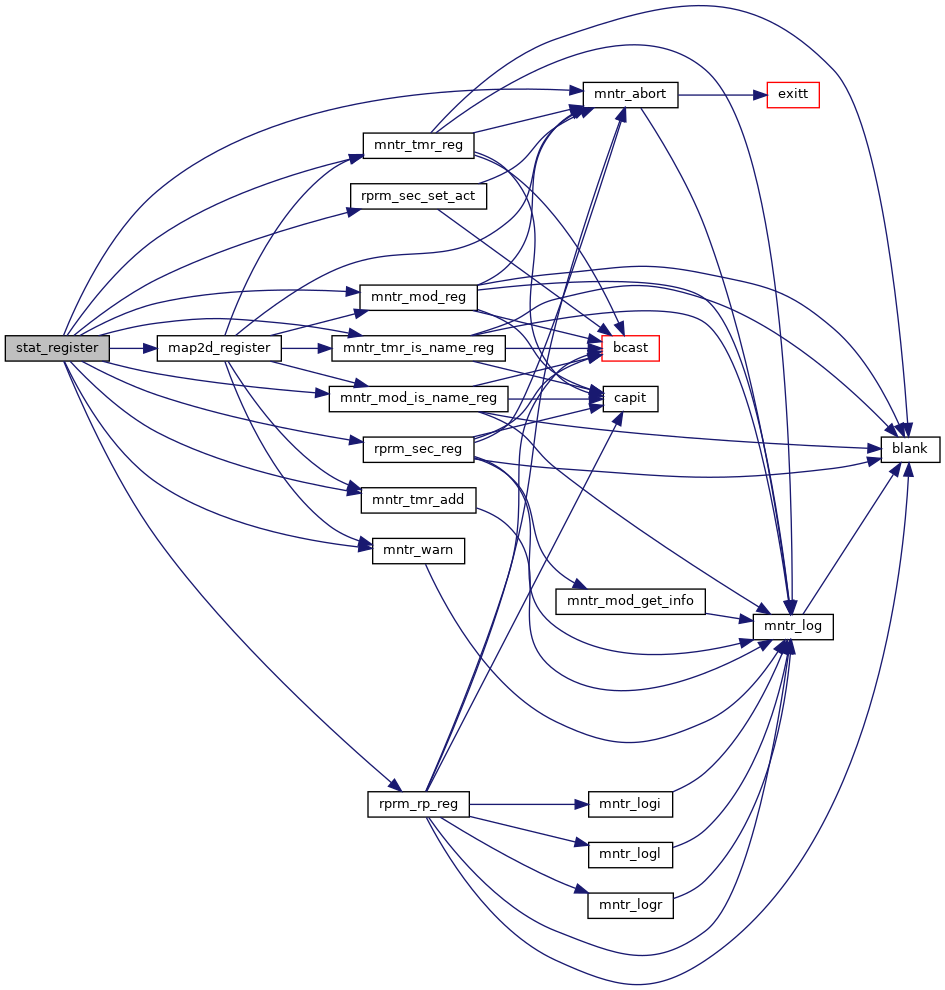Set of routines to collect 44 fields for statistics. More...
 Collaboration diagram for 2D and 3D statistics module:
Collaboration diagram for 2D and 3D statistics module:Files | |
| file | stat.f |
| 2D and 3D statistics module | |
| file | stat_IO.f |
| IO routines for 2D/3D statistics module. | |
Functions | |
| subroutine | stat_register () |
| Register 2D and 3D statistics module. More... | |
| subroutine | stat_init () |
| Initilise statistics module. More... | |
| subroutine | stat_end () |
| Finalise statistics module. More... | |
| logical function | stat_is_initialised () |
| Check if module was initialised. More... | |
| subroutine | stat_avg |
| Main interface of statistics module. More... | |
| subroutine | stat_init_int1d () |
| Get local integration coefficients. More... | |
| subroutine | stat_reshufflev (rvar, var, nl) |
| Array reshuffle. More... | |
| subroutine | stat_compute_1dav1 (lvar, npos, alpha, beta) |
| Perform local 1D integration on 1 variable. More... | |
| subroutine | stat_compute_1dav2 (lvar1, lvar2, npos, alpha, beta) |
| Perform local 1D integration on multiplication of 2 variables. More... | |
| subroutine | stat_gs_sum |
| Global statistics summation. More... | |
| subroutine | stat_compute () |
| Compute statistics. More... | |
| subroutine | stat_mfo () |
| Main interface for saving statistics. More... | |
| subroutine | stat_mfo_outfld3d () |
| Statistics muti-file output of 3D data. More... | |
| subroutine | stat_mfo_outfld2d () |
| Statistics muti-file output of 2D data. More... | |
| subroutine | stat_mfo_write_hdr2d |
| Write hdr, byte key, global ordering of 2D data. More... | |
| subroutine | stat_mfo_write_stat2d |
| Write additional data at the end of the file. More... | |
| subroutine | stat_mfo_crd2d |
| Write element centres to the file (in case of AMR level as well) More... | |
Detailed Description
Set of routines to collect 44 fields for statistics.
This set of routines performs temporal, and, in case of the 2D version, spanwise averaging of some 44 different fields, which include selected statistical moments of velocity and pressure up to fourth order. A full list of fields is provided in the field_list.txt file located in the same directory as this file. Please note that there is no abuse of notation in the names of the quantities, e.g. <uu> actually means <uu> and not <u'u'>.
As metioned above, the module can operate in two regimes, 2D and 3D. In the 3D case, the fields are only averaged in time, whereas in 2D the they are also averaged spatially along a chosen homogeneous direction. To select the mode of operation, the parameter stat_rdim defined in the include file STATD should be set to either 1 for 2D statistics or 0 for 3D. A template for this file is provided in this directory, you should copy it to your case folder and rename it to STATD.
In the case of 2D statistics, the index of the homogeneous direction should be selected as well. This is done by setting the idir variable in the user_map2d_get subroutine, which should be copied into your .usr file. The module will compute the statistics based on sampling the solution every AVSTEP iterations. At each IOSTEP iteration, two files will be output with prefix c2D and sts, respectively. Important: the whole simulation must be run on the same number of ranks!
Each sts file will hold the data averaged over IOSTEP iterations. IOSTEP is thus both the averaging window length and the frequency of output. The sts files are in the same format as Nek5000 output files, meaning that they can, for example, be opened with Paraview or other tools. See also pstat2d in this Toolbox for ways of extracting data from sts files: averaging across sts files, computing additional fields, extracting data at arbitrary points.
The c2D files store the element numbering in the sts-file mesh, the centres of these elements, and also the level of refinement (used for adaptive mesh refinement). This information is used by the pstat2d tool.
In the case of 3D statistics, 11 files, s01* to s11* will be written each IOSTEP iterations. Like with the 2D statistics, these will hold quantities averaged over IOSTEP iterations. Each file holds 4 fields, the distribtuion of quantities across the files is provided in the field_list.txt file in this directory. The files can also be opened in e.g. Paraview, but one should be aware that the names of the fields are always x_velocity, y_velocity, z_velocity and temerature. These names have nothing to do with the physical quantity stored. Instead, one should consult field_list.txt and map the 4 quantities listed there to the names above, in the order listed. Post-processing of the produced fields can also be performed with the pstat3d tool.
- Module interface:
- Global interface list:
- Interface provided:
- Global interface dependency:
- Interface required:
- multiple interfaces from Runtime parameters and Monitoring module modules
- map2d_register , map2d_init and map2d_get from Grid mapping module (automatically registered)
- user_stat_trnsv; user defined
- Warning
- This module depends on Grid mapping module and (user_map2d_get) has to be provided irrespective of the spanwise average being performed or not. In case only the time average is performed (stat_rdim=0 in STATD) user_map2d_get should be empty, but stil present. However, Grid mapping is automatically registered by statistics tool, so there is no need to add it to frame_usr_register and frame_usr_init.
- Note
- user_stat_trnsv is a user provided interface for both statistics and Time history for set of points modules.
- Module interface usage:
- !======================================================================subroutine userchkinclude 'TSTEP'if (istep.eq.0) then! start frameworkcall frame_startendif! monitor simulationcall frame_monitor! collect statisticscall stat_avg! finalise frameworkif (istep.eq.nsteps.or.lastep.eq.1) thencall frame_endendifreturnend!======================================================================subroutine frame_usr_registerimplicit noneinclude 'SIZE'include 'FRAMELP'!-----------------------------------------------------------------------! register modulescall stat_registerreturnend subroutine!======================================================================subroutine frame_usr_initimplicit noneinclude 'SIZE'include 'FRAMELP'!-----------------------------------------------------------------------! initialise modulescall stat_initreturnend subroutine!======================================================================subroutine frame_usr_endimplicit noneinclude 'SIZE'include 'FRAMELP'!-----------------------------------------------------------------------! finlise modulescall stat_endreturnend subroutine!=======================================================================!=======================================================================subroutine user_stat_trnsv(lvel,dudx,dvdx,dwdx,vort,pres)implicit noneinclude 'SIZE'include 'SOLN'include 'INPUT' ! if3dinclude 'GEOM'! argument listreal lvel(LX1,LY1,LZ1,LELT,3) ! velocity arrayreal dudx(LX1,LY1,LZ1,LELT,3) ! velocity derivatives; Ureal dvdx(LX1,LY1,LZ1,LELT,3) ! Vreal dwdx(LX1,LY1,LZ1,LELT,3) ! Wreal vort(LX1,LY1,LZ1,LELT,3) ! vorticityreal pres(LX1,LY1,LZ1,LELT) ! pressure! local variablesinteger itmp ! dummy variableinteger il, jl ! loop indexinteger ifll ! field number for object definitionreal vrtmp(lx1*lz1) ! work array for facereal vrtmp2(2) ! work array! functionsreal vlsum!-----------------------------------------------------------------------! Velocity transformation; simple copyitmp = nx1*ny1*nz1*nelvcall copy(lvel(1,1,1,1,1),vx,itmp)call copy(lvel(1,1,1,1,2),vy,itmp)call copy(lvel(1,1,1,1,3),vz,itmp)! Derivative transformation! No transformationcall gradm1(dudx(1,1,1,1,1),dudx(1,1,1,1,2),dudx(1,1,1,1,3),$ lvel(1,1,1,1,1))call gradm1(dvdx(1,1,1,1,1),dvdx(1,1,1,1,2),dvdx(1,1,1,1,3),$ lvel(1,1,1,1,2))call gradm1(dwdx(1,1,1,1,1),dwdx(1,1,1,1,2),dwdx(1,1,1,1,3),$ lvel(1,1,1,1,3))! get vorticityif (if3d) then! curlxcall sub3(vort(1,1,1,1,1),dwdx(1,1,1,1,2),$ dvdx(1,1,1,1,3),itmp)! curlycall sub3(vort(1,1,1,1,2),dudx(1,1,1,1,3),$ dwdx(1,1,1,1,1),itmp)endif! curlzcall sub3(vort(1,1,1,1,3),dvdx(1,1,1,1,1),dudx(1,1,1,1,2),itmp)! normalise pressure! in this example I integrate pressure over all faces marked "W"ifll = 1 ! I'm interested in velocity bcobj_srfl = 0.0 ! initialise object surfacepmeanl = 0.0 ! initialise pressure meanitmp = lx1*lz1do il=1,nelv ! element loopdo jl=1,2*ldim ! face loopif (cbc(jl,il,ifll).eq.'W ') thenvrtmp2(1) = vrtmp2(1) + vlsum(area(1,1,jl,il),itmp)call ftovec(vrtmp,pres,il,jl,lx1,ly1,lz1)call col2(vrtmp,area(1,1,jl,il),itmp)vrtmp2(2) = vrtmp2(2) + vlsum(vrtmp,itmp)enddoenddo! global communication! missing error check vrtmp2(1) == 0vrtmp2(2) = -vrtmp2(2)/vrtmp2(1)! remove mean pressureitmp = nx1*ny1*nz1*nelvcall cadd(pres,vrtmp2(2),itmp)returnend subroutine!=======================================================================
- Module parameters:
- Global parameter list:
- Parameters provided by stat module (include file - STATD):
| Varaible | Type | Runtime parameter | Description |
|---|---|---|---|
| stat_avstep | integer | _stat:AvStep | frequency of averaging |
| stat_skstep | integer | _stat:SkStep | skipped initial steps |
| stat_IOstep | integer | _stat:IOStep | frequency of saving data to the disc |
- Module parameter usage:
- [_STAT] # Runtime parameter section for statistics moduleAVSTEP = 10 # The frequency, in time-steps, at which the solution is sampledSKSTEP = 2 # Skipped initial stepsIOSTEP = 50 # The output frequency, in time-steps, which also defines the averaging window
Function Documentation
◆ stat_avg()
| subroutine stat_avg |
Main interface of statistics module.
This routine performs time averaging and file writing.
- Note
- This routine should be called in userchk during every step
Definition at line 236 of file stat.f.
References mntr_log(), mntr_tmr_add(), rzero(), stat_compute(), stat_gs_sum(), and stat_mfo().
 Here is the call graph for this function:
Here is the call graph for this function:◆ stat_compute()
| subroutine stat_compute |
Compute statistics.
- Remarks
- This routine uses global scratch space SCRMG, SCRUZ, SCRNS, SCRSF
Definition at line 762 of file stat.f.
References add2(), col3(), copy(), mappr(), mntr_log(), stat_compute_1dav1(), stat_compute_1dav2(), and stat_reshufflev().
 Here is the call graph for this function:
Here is the call graph for this function: Here is the caller graph for this function:
Here is the caller graph for this function:◆ stat_compute_1dav1()
| subroutine stat_compute_1dav1 | ( | real, dimension(lx1,ly1,lz1,lelt) | lvar, |
| integer | npos, | ||
| real | alpha, | ||
| real | beta | ||
| ) |
Perform local 1D integration on 1 variable.
- Parameters
-
[in] lvar integrated variable [in] npos position in stat_ruavg [in] alpha,beta time averaging parameters
- Remarks
- This routine uses global scratch space CTMP0
Definition at line 565 of file stat.f.
References add2sxy(), mntr_abort(), and rzero().
 Here is the call graph for this function:
Here is the call graph for this function: Here is the caller graph for this function:
Here is the caller graph for this function:◆ stat_compute_1dav2()
| subroutine stat_compute_1dav2 | ( | real, dimension(lx1,ly1,lz1,lelt) | lvar1, |
| real, dimension(lx1,ly1,lz1,lelt) | lvar2, | ||
| integer | npos, | ||
| real | alpha, | ||
| real | beta | ||
| ) |
Perform local 1D integration on multiplication of 2 variables.
- Parameters
-
[in] lvar1,lvar2 integrated variable [in] npos position in stat_ruavg [in] alpha,beta time averaging parameters
- Remarks
- This routine uses global scratch space CTMP0
Definition at line 622 of file stat.f.
References add2sxy(), col3(), mntr_abort(), and rzero().
 Here is the call graph for this function:
Here is the call graph for this function: Here is the caller graph for this function:
Here is the caller graph for this function:◆ stat_end()
| subroutine stat_end |
Finalise statistics module.
- Note
- This routine should be called in frame_usr_end
Definition at line 185 of file stat.f.
References mntr_log(), mntr_tmr_add(), stat_gs_sum(), and stat_mfo().
 Here is the call graph for this function:
Here is the call graph for this function:◆ stat_gs_sum()
| subroutine stat_gs_sum |
◆ stat_init()
| subroutine stat_init |
Initilise statistics module.
- Note
- This routine should be called in frame_usr_init
Definition at line 110 of file stat.f.
References map2d_init(), mntr_log(), mntr_tmr_add(), mntr_warn(), rprm_rp_get(), rzero(), and stat_init_int1d().
 Here is the call graph for this function:
Here is the call graph for this function:◆ stat_init_int1d()
| subroutine stat_init_int1d |
Get local integration coefficients.
This version does 1D integration over one of the directions R,S,T. It supports curved coordinate systems, however axisymmetric 2.5D cases are not supported
- Remarks
- This routine uses global scratch space SCRSF
Definition at line 309 of file stat.f.
References add2(), copy(), mntr_abort(), mxm(), rzero(), stat_reshufflev(), vsq(), and vsqrt().
 Here is the call graph for this function:
Here is the call graph for this function: Here is the caller graph for this function:
Here is the caller graph for this function:◆ stat_is_initialised()
| logical function stat_is_initialised |
◆ stat_mfo()
| subroutine stat_mfo |
Main interface for saving statistics.
Definition at line 12 of file stat_IO.f.
References stat_mfo_outfld2d(), and stat_mfo_outfld3d().
 Here is the call graph for this function:
Here is the call graph for this function: Here is the caller graph for this function:
Here is the caller graph for this function:◆ stat_mfo_crd2d()
| subroutine stat_mfo_crd2d |
Write element centres to the file (in case of AMR level as well)
Definition at line 484 of file stat_IO.f.
References blank(), byte_close, byte_close_mpi(), byte_set_view(), byte_write, byte_write_mpi(), crecv(), csend(), igllm(), mfo_open_files(), mntr_check_abort(), mxm(), and zwgll().
 Here is the call graph for this function:
Here is the call graph for this function: Here is the caller graph for this function:
Here is the caller graph for this function:◆ stat_mfo_outfld2d()
| subroutine stat_mfo_outfld2d |
Statistics muti-file output of 2D data.
This routine is just modification of mfo_outfld
- Remarks
- This routine uses global scratch space SCRUZ
Definition at line 102 of file stat_IO.f.
References byte_close, byte_close_mpi(), byte_set_view(), copy(), mfo_open_files(), mfo_outs(), mntr_check_abort(), stat_mfo_crd2d(), stat_mfo_write_hdr2d(), and stat_mfo_write_stat2d().
 Here is the call graph for this function:
Here is the call graph for this function: Here is the caller graph for this function:
Here is the caller graph for this function:◆ stat_mfo_outfld3d()
| subroutine stat_mfo_outfld3d |
◆ stat_mfo_write_hdr2d()
| subroutine stat_mfo_write_hdr2d |
Write hdr, byte key, global ordering of 2D data.
This routine is just modification of mfo_write_hdr
- Remarks
- This routine uses global scratch space CTMP0
Definition at line 318 of file stat_IO.f.
References blank(), byte_set_view(), byte_write, byte_write_mpi(), crecv(), csend(), and mntr_check_abort().
 Here is the call graph for this function:
Here is the call graph for this function: Here is the caller graph for this function:
Here is the caller graph for this function:◆ stat_mfo_write_stat2d()
| subroutine stat_mfo_write_stat2d |
◆ stat_register()
| subroutine stat_register |
Register 2D and 3D statistics module.
- Note
- This routine should be called in frame_usr_register
Definition at line 12 of file stat.f.
References map2d_register(), mntr_abort(), mntr_mod_is_name_reg(), mntr_mod_reg(), mntr_tmr_add(), mntr_tmr_is_name_reg(), mntr_tmr_reg(), mntr_warn(), rprm_rp_reg(), rprm_sec_reg(), and rprm_sec_set_act().
 Here is the call graph for this function:
Here is the call graph for this function:◆ stat_reshufflev()
| subroutine stat_reshufflev | ( | real, dimension(lx1,ly1,lz1,lelt) | rvar, |
| real, dimension(lx1,ly1,lz1,lelt) | var, | ||
| integer | nl | ||
| ) |
Array reshuffle.
Reorder directions in such a way that the uniform direction corresponds to the the first index
- Parameters
-
[out] rvar reshuffled array [in] var input array [in] nl element number to reshuffle
Definition at line 496 of file stat.f.
References copy().
 Here is the call graph for this function:
Here is the call graph for this function: Here is the caller graph for this function:
Here is the caller graph for this function:
